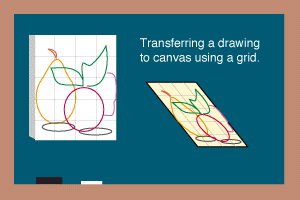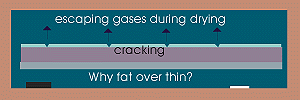The process of creating a painting varies from medium to medium and from individual to individual. It is best to have a canvas or panel with a prepared ground, painting tools, a medium (either oil or gel for acrylic), and some solvent (either mineral spirits or water for acrylic). Here is a general outline of a painting process that you may use to get started. |
|
|
| The Drawing or Cartoon: When one has decided on a composition that they would like to produce as a painting, The first thing that they must do is transfer that idea to the canvas. This is usually done in the form of a freehand drawing sometimes called the cartoon. One can translate a drawing with great accuracy by using a grid which has been drawn over the original, then creating a larger grid on the canvas. One has to merely follow the same patterns. The use of overhead projectors is also quite common and perfectly acceptable. Because of the transparency of many pigments, it is advisable to do this drawing with a thin wash of a neutral color like raw umber or yellow ochre using one of your brushes. |  |  |
|
|
Color and Palette: After one has drawn the image it is important to evaluate the color that will be used. Create limitations on color. Choose a specific "palette" of colors to use on your palette. For example if you are painting some foliage, you may want to stick with blues, yellows and greens of varying intensity and perhaps use a red as an accent. Since red is a complementary color to green it helps to activate it. By setting aside some color, like browns or oranges, you can focus the color so that your color information is more specific. Avoid trying to use all the colors in one painting and don't underestimate the power of neutral colors in a composition.
Planes: Look carefully at the subject matter that you are using as source material. In painting, unlike drawing, line is created where two planes of color come together. Allow background color to meet at the edge of an object to create line rather than outlining a form. Within an object there is also a series of changing planes that vary depending on how light is acting upon the object. Click here for a good example of planes as they occur in gray values. |
|
|
| Hint: Try to work fat over thin, that is, as you build up layers in your painting make each successive layer the same or slower in its drying time. One does this because slower drying in the underpainting can result in cracking caused by escaping gases from areas which are not completely dry. In oil painting, solvents speed drying time and oils slow it down. Work with more oil in the upper layers and more solvents in the lower ones. Fat over thin is also important in acrylic painting. Use gels that slow drying in the upper layers.
| |  | 
|
|
|
Hints for Evaluating a Painting:
- Turn the painting upside down. If the composition is still interesting then it is successful. Good composition works from all angles.
- Squint to evaluate value. Color can sometimes confuse and squinting helps to limit color so that light or dark value can be seen.
- Check to see if the corners and edges seem incomplete. If they are not well painted, it will impact on the entire painting. Make every inch of a painting just as important as the one next to it.
- Find a particular color and see if it exists in more than one place. Color can create or confuse a composition. By repeating a color in several places throughout the painting, one can create a more cohesive composition. This is called Repetition of an Element and can be done with line, form, or color.
updated 07/14/04 |
|
|


